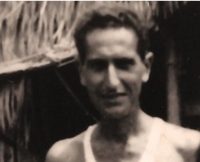Still in Santa Ana. A little surprised still to be free. This morning L.R. [Le Roch, the French Consul] comes to see
Anne and is not very encouraging about my situation. He’s accompanied by his charming young wife and the captain of the Sikiang, who was wounded in the arm when his ship was bombed by the Japanese. They’re all wearing a tricolor ribbon. Le Roch seems agitated. I find out later that he has shown himself to be extremely decent throughout this whole business.
Yesterday afternoon, my first visit to town to fetch milk at Azcarraga. I take the long orange tram that goes from Santa Ana. The rarity of cars is surprising as is the absence of “Whites”. Every car you see is carrying a Japanese
pennant. A few others fly the swastika or the Spanish or Swiss flag. Am not bothered on the way. Here and there buildings occupied by the Japanese — the YWCA, the Jai Alai, etc. In front of the Jai Alai, an endless queue of Filipinos buying rice (rationed). In front of Nestlé’s it’s a virtual battleground, but I manage to get my cartons easily. I return in a caramata and get stopped in front of a station by a Japanese sentry accompanied by a civilian (Chinese, I think) acting as interpreter. “Americano?” he asks. I reply by showing him my passport. The sentry seems a nice young boy with fat cheeks and a smiling face. He lets me go without causing me the slightest difficulty.
This morning I return to town. Not a single car in the Escolta. Very few shops open (Swiss, Filipino and Indian). Lots of people — Filipinos and neutrals. A Spaniard I know says to me, “Glad to see you out.” We’re like survivors from a shipwreck — the Americans and British, including women and children, are all interned in Santo Tomas. There are swarms of Japanese buying in the shops. They’re behaving very properly and appear to be outdoing each other in politeness. From Jones Bridge, the scene is one of ruin. On the river, three or four stranded boats, their upper parts burnt out. Towards the Old Town, the ruins of Santo Domingo, and buildings blackened by flames.
I arrive at the LW Hotel where there are only neutrals left. [Leonard Wood Hotel, 625 Calle Dakota, Malate] Because it’s been requisitioned, they’re moving out. The Swedish gentleman is talking quietly to a Japanese officer who is being very polite.
In our neighborhood everything is very calm. Every day we go for a walk in the vicinity of the Spanish church of Santa Ana or along the river — dirty and foul-smelling, but the sight it offers seems to delight the children. The church is built of red brick. One of its facades must be quite old. Its false columns and complicated ornamentation betray the Spanish baroque style which is found everywhere in the Philippines. Its tower is in a
grey metal which from a distance is reminiscent of slate — so much so that if you view it standing back with its fagade hidden by the clumps of trees, you could mistake it for a village church in France.
There is nothing to remind you that you’re in the tropics, and the coolness of the season adds to the illusion.
